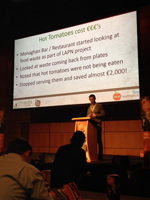Minimise waste/increase profit

Colum discovered that in one Monaghan pub, no one was eating the hot tomatoes garnishing the main dishes. Taking the decision to stop including them saved the pub almost €2,000 per year.
He was speaking as part of the Pubs Educational Programme at this year’s Alltech International Brewing and Craft Fair held recently in Dublin’s National Convention Centre.
His theme, ‘Taking a Drink and Food Inventory: Minimise Waste and Increase Margin’ had some useful tips.
Some 450,000 tonnes of food waste are generated by our food producers annually while commercial waste including the wholesale, retail and service industries, hospitals, universities and canteens, is responsible for 340,000 tonnes.
Altogether we produce over 1 million tonnes of food waste.
Hotels constitute the main food waste producers being responsible for 27.2% of total waste while restaurants are responsible for 14.5% and food retail operations for 23.2%.
Hidden costs in food waste
It has been estimated that each tonne of food waste costs between €2,000 and €5,000. This figure comprises disposal costs (roughly 10%) as well as the purchase cost and the costs to cook and manage the food on-site. Your waste contractors should be able to supply your annual waste tonnage, he said.
Publicans wishing to prevent food waste and thus save money should:
- Identify the amount of food waste being generated by the operation
- Determine the locations, types and specific volumes being generated
- Figure out the reasons why this is being generated
- Come up with solutions to prevent this waste at source.
60% of food waste is avoidable (plate scrapings, leftovers, gone-off fruit and veg, ‘passed date’ items and damaged stock which cannot be used due to H&S etc).
20% is potentially avoidable (bread crusts or heels could be made into breadcrumbs, vegetable trimmings could be used for stock and soups, meat and fish bones could be used for stock, discarded butter could be used in cooking and old fruit could be used for jams and smoothies etc).
20% is unavoidable waste (banana skins, animal bones – before or after stock-making, unusable prep waste such as potato peels with soil on them etc).
Fine examination of food waste
Food waste should be examined down to individual cover levels for a few days to assess the average food waste per cover. Remedying this waste at cover level can consist of simple steps. For example bread waste can be cut down by offering slices of bread to the customers and returning frequently to offer more rather than using a basket of bread at a table.
Colum discovered that in one Monaghan pub, no one was eating the hot tomatoes garnishing the main dishes. Taking the decision to stop including them saved the pub almost €2,000 per year.
In another example, better portion control in a hotel led to savings of 50% to 60% per cover.
By measuring the weight of food ‘in’ and ‘out’ during the entire month of May, one premises was able to make a series of improvements by altering the bin position and size, elevating staff awareness of what is waste and what is not, placing a huge focus on portion size as well as ‘what’s selling’ and ‘what is not selling’ feedback to the kitchens directly from staff. All staff were involved in this exercise.
The number of grammes of waste per customer subsequently improved and measured, establishing this at a 115 gramme average set against the Sustainable Restaurant Association average of 480 grammes.
Food waste equals money waste and in the catering sector it accounts for over €2 million, Colum reminded the audience.
Other sources of waste
Pubs should also check their water meter at night and again in the morning to discover whether there’s a leak or any other form of water waste such as uncontrolled urinals. Six litres is considered plenty for flushing a toilet.
Other cost considerations cited by Colum included:
* hot water is at least four times the cost of cold water
* using low energy LEDs is the way forward
* find out your main energy-using points in the premises.
Check that things that shouldn’t be on at night are not left on such as dishwashers and the bains marie (which when being used should be filled with hot water, not cold water, he advised).
In October 2012 an assessment was made of the monthly cost per appliance in a catering establishment.
The biggest cost at €128.91 was for the bain marie followed by the panwasher at €107.3 and the dishwasher at €113.56.
Beware of extractor fans, too, he warned, use a variable-speed drive motor, correctly size the fan and only use it when needed. Link it to a thermostat or other sensor to save money.








